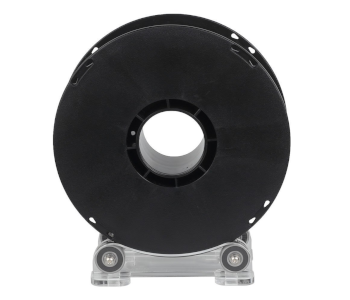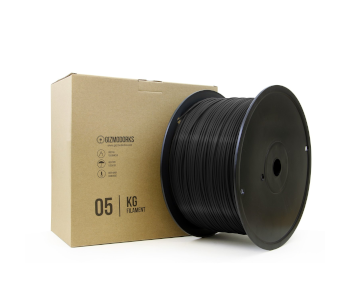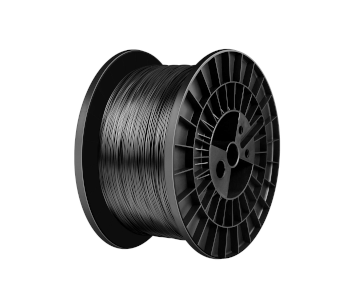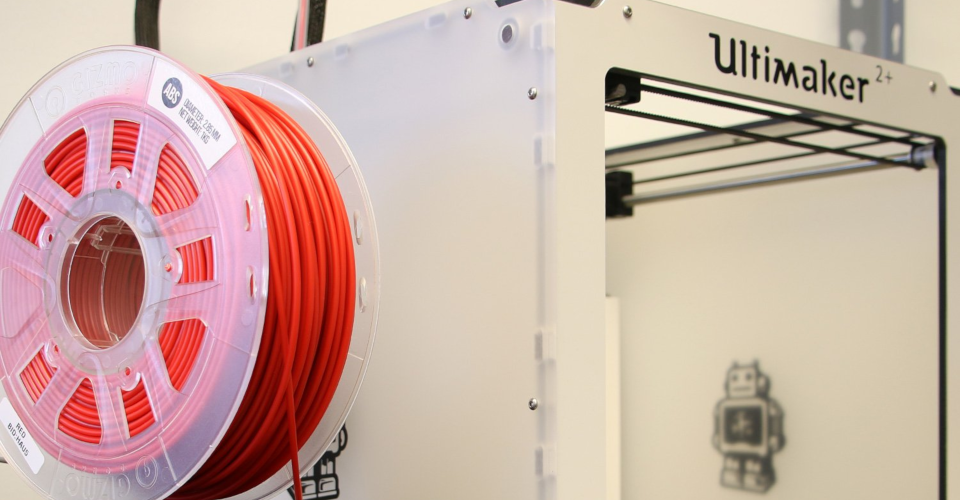Buying 3D Printing Filament in Bulk
One of our most favorite things about FDM printing is that it’s incredibly easy to swap one filament for another. If you’re tired of your plain old Natural PLA, then you take out that spool of colored ABS you’ve been keeping in storage.
However, some jobs benefit from sticking to a single roll of filament. When this situation comes up, you might want to have an extra-large roll of filament on hand. Recognizing this need, some filament manufacturers offer bulk or extra-large filament spools. Is it a good idea to buy filament in bulk?
Should you buy filament in bulk?
While most 3D printing filaments come in spools of 1 kilogram or less, the bulk filament can have as much as 15 kilograms of filament wound on a single spool. As you can tell, this can be a pretty big commitment. Before deciding to get an extra-large spool of filament, here are a couple of things you need to ensure:
You’re working on a large project
People often decide to buy filament in bulk when they expect to have to work on projects that are either exceptionally large or require a huge volume. A 3D printer that runs continuously can consume anywhere between two to four kilograms of filament in a day. If this kind of situation sound familiar to you, then an extra-large spool of filament seems like a practical option.
You’ve tested the specific filament brand before
As we’ve said, buying filament in bulk is a huge commitment. Not only are you going to be obliged to use up a lot of filament, but you’re likely going to pay $300 or more for a single spool. This is fine if you encounter no problems with your filament and it prints really well.
However, the opposite would be a huge headache. If you purchased filament in bulk from a brand you have not tested before, only to find problems with its quality and consistent, then you’re pretty much stuck with a huge amount of unprintable filament. This emphasizes the importance of due diligence – buy a smaller spool from a brand first before you decide to buy in bulk.
You have a suitable spool holder

Most 3D printers come with a spool holder located somewhere at its side or at the top. These are meant for the standard 3D filament spools that weigh 1 kilogram or less. However, you might need a more rugged spool holder if you intend to get bulk filament.
Make sure that your spool holder is rated for the weight of filament that you will be using. Some use a strong spool holder that can stand up on the desk beside the 3D printer. This filament holder from Creker is a good example. It basically acts as “feet” for the filament spool and has internal bearings that allow the spool to rotate freely.
For a space-saving solution, you can also wall-mount a spool holder. Screwing it in place is essential, especially if you’re buying a spool that weighs more than 10 kilograms.
You have storage space
Even if you’re working on a huge project, there is still a remote possibility that you will end up with leftover filament. The problem with extra-large spools of filament is that even the plastic spools are large, regardless of how much filament you have left. This makes storage somewhat challenging. If you’re buying large filament, make sure that you have vacuum bags large enough to fit its spool and that it will fit in your storage space.
In summary, buying filament in bulk is a good idea if you have a big project for which you’ll use it for, you trust the brand you’re buying from, and you have the essential accessories to handle and store such a huge spool. This is not the kind of thing that you buy on impulse.
Pros and cons of buying filament in bulk
If you’ve made up your mind about deciding to buy an extra-large filament spool, then you would be pleased to know that it’s something that a lot of 3D printing professionals do. It certainly has its perks, but keep in mind that there are few drawbacks to using and keeping that much filament.
PROS:
Consistency
If you’re working on a single huge model or several smaller models using a single filament, then using just a single spool should provide a better assurance that your finished prints will be more consistent quality-wise. Consistency is often a problem when you need to change between filament spools in the middle of a print. Having a large filament ensures that this won’t ever be a problem again.
Speed
Speaking of changing over when a filament runs out, this step requires that you stop printing, clean out the residual filament, and feed the new filament into the printer. This can take a few minutes. For high-volume orders, you may need to do this step two or three times in a single day, slowing down the process significantly. By cutting down on delays due to changeover, you can finish the job a bit quicker.
Convenience
Having to swap spools in the middle of a print also means that you have to physically be there to do the job. A single 3D print takes several hours, and it’s not uncommon for users to walk away from the printer and do more productive things.
When a filament runs out, you pretty much have to drop what you’re doing and rush to replace the filament before the last layer that was printed starts to get cold. This is incredibly inconvenient, especially if you have to do it several times a day. You can consider an extra-large filament as a quality of life improvement that lets you wander away from your 3D printer for longer without worries.
Cheaper

Theoretically, 3D printing filaments should follow an economy of scale. This means that they should cost less per gram when you buy more of them. For instance, a 1-kilogram spool of ABS filament from Gizmo Dorks costs about $20.95. A 5-kilogram spool of the same filament costs around $99.95. Granted that the savings aren’t so big in this particular example, but they should get bigger if you buy larger spools.
CONS:
Inherent risk
Whenever you buy anything in bulk, there is always an inherent risk of you ending up with a huge stock of low-quality products. The same can be said of 3D printing filaments. We would hate to buy a 10-kilogram spool only to find that it has issues with bubbles and size consistency. To avoid this, it’s very important to buy bulk filament only from brands that you can strongly vouch for. Otherwise, you could end up with a hundred-dollar paperweight.
Difficult to mount
3D printers simply aren’t built to carry the weight of large filament spools. As we’ve mentioned, you can buy special filament holders that attach to the edges of spools to keep them upright. We prefer making a wall mount for the spool so it can still above the 3D printer, allowing for a smoother feed. In either case, you’re going to have to retrofit your setup to accommodate a super-sized filament roll.
Hard to keep dry
Most 3D printing professionals know that moisture is the number one enemy of plastic filaments. With enough moisture absorption, a filament can have micro-bubbles that expand and explode when exposed to heat. This could easily lead to ruined prints or jammed nozzles.
One issue to anticipate when buying large filament rolls is that they are also harder to dry because of their sheer volume. Simply put, more filament means more moisture retention. If you oven-dry your filament before use, then you’ll have to check if the filament will fit in your oven and determine how much longer you need to leave it inside.
Moisture absorption is also a potential problem if you use a huge filament spool for extra-long printing sessions. Exposing the filament to the atmosphere for a few hours is one thing, but it’s a completely another thing to leave it the spool mounted near your 3D printer for several days.
In most cases, buying filament in bulk is a matter of convenience. You won’t need to buy filament as often, will change filament spools less frequently, and are assured of more consistent output quality. You may have to modify your practices and set-up to adapt to a larger filament, but the efforts are well worth the improvement in the quality of life.
Recommendations for bulk filament
There aren’t many filament brands that outright offer extra-large filaments in their standard product line. Perhaps this is a testament to how little the demand is for filaments in bulk. However, they usually accept custom orders for larger spools depending on what you need. If you have a favorite filament brand, then the best option would be to call them or shoot them an e-mail.
However, it’s not impossible to find larger than usual filament spools that are being sold directly. The following are a few of the best options we’ve stumbled upon:
1. Gizmo Dorks PLA Filament 5 kg.

Quality is very important when buying extra-large filament spools, so we’re quite partial to the popular filament brands Gizmo Dorks. They have been around for a long time and their filaments are some of the most reliable in the market. This assurance of quality is enough to justify this moderately expensive spool of PLA filament.
2. Tianse 3D Printer PLA Filament 5 kg.

If the 5-kilogram PLA filament from Gizmo Dorks feels a bit too expensive for you, then you can save around $15 with this spool from Tianse. It weighs the same and has the same color. The only difference is that it comes from a less popular brand. Despite being less expensive, the Tianse PLA filament has proven to be consistent enough for 3D printing professionals to finish whole 5-kilogram rolls.
3. Gizmo Dorks HIPS Filament 5 kg.

Both PLA and ABS are old hats when it comes to 3D printing, so large-sized spools of these two filaments are pretty commonplace. This 5-kilogram spool of HIPS filament from Gizmo Dorks simply illustrates that it’s also possible to get extra-large spools of more exotic filament types. If you haven’t used HIPS before, its primary use case is as a support material that is most compatible with PLA. If you need to print a large model using PLA, then having 5-kilogram spools of PLA and HIPS printing on a multi-extruder system sounds like a winning combination.
Final thoughts
Having a huge selection of different filament types and colors is well and good until you need just one particular filament and find that you have no spares. If you anticipate doing huge jobs soon, then buying a large filament may be the more prudent move.
Before you spend a hundred dollars on some large filament spool, make sure that you’re getting it from a brand you trust and that you have the necessary accessories to handle it. With just a little planning, you may be convinced to never go back to those tiny 1-kilogram spools.





